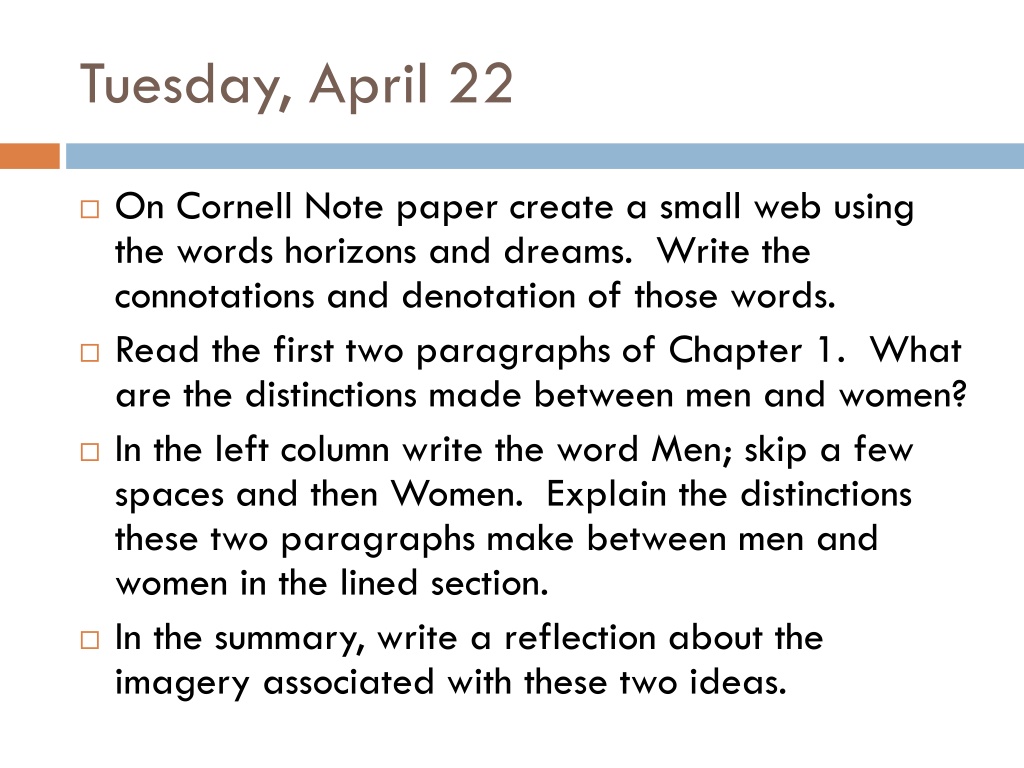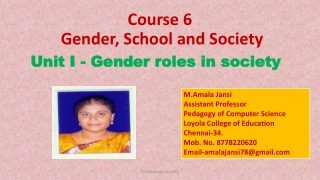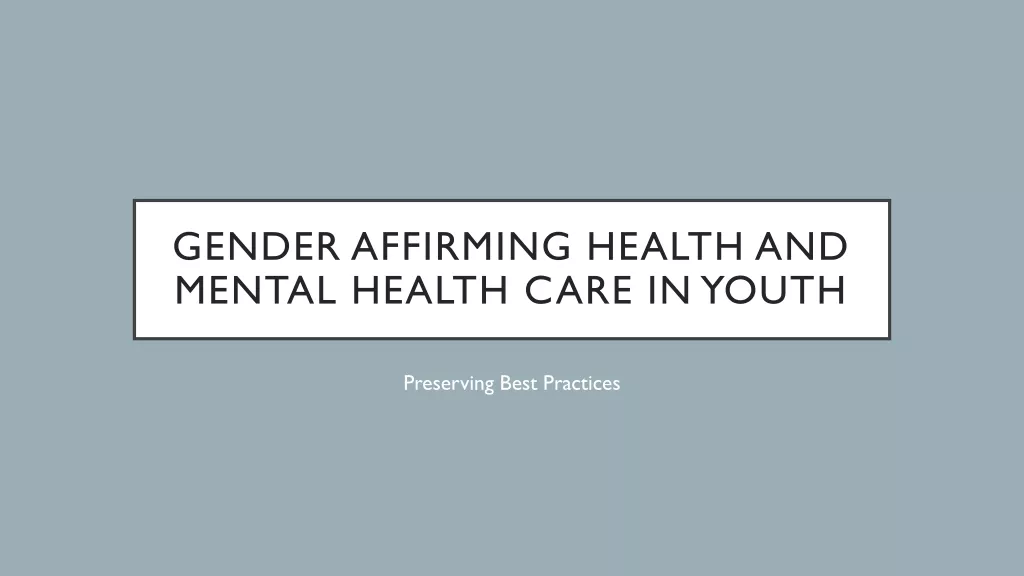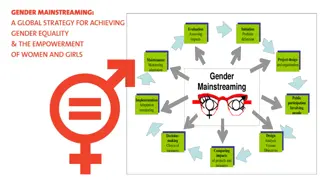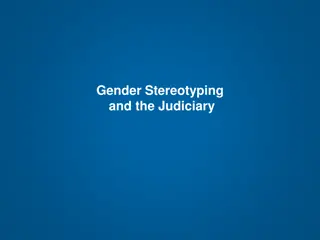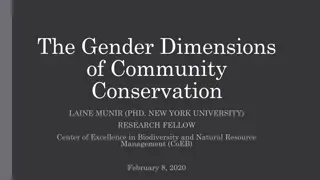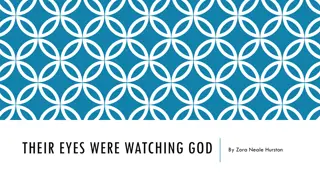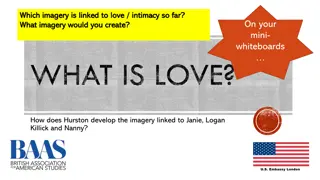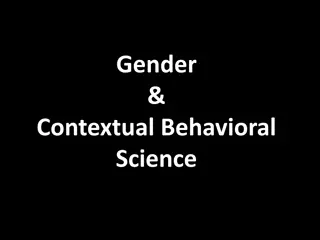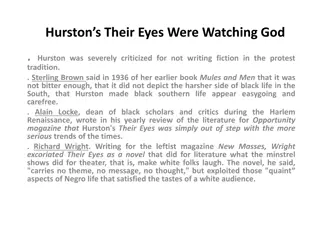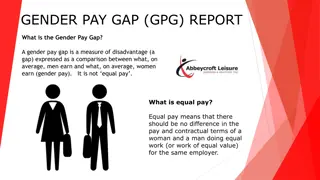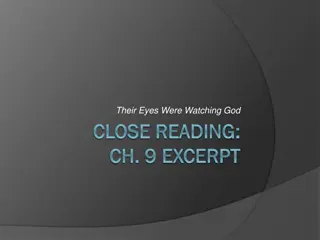Exploring Gender Dynamics in "Their Eyes Were Watching God
In "Their Eyes Were Watching God," the themes of self-discovery and acceptance are explored through the experiences of Janie Crawford. The novel delves into the nuances of relationships and societal expectations, particularly how men and women are perceived and treated differently. The vivid imagery and rich symbolism in the narrative enhance the exploration of identity and empowerment.
Download Presentation

Please find below an Image/Link to download the presentation.
The content on the website is provided AS IS for your information and personal use only. It may not be sold, licensed, or shared on other websites without obtaining consent from the author. Download presentation by click this link. If you encounter any issues during the download, it is possible that the publisher has removed the file from their server.
E N D
Presentation Transcript
Tuesday, April 22 On Cornell Note paper create a small web using the words horizons and dreams. Write the connotations and denotation of those words. Read the first two paragraphs of Chapter 1. What are the distinctions made between men and women? In the left column write the word Men; skip a few spaces and then Women. Explain the distinctions these two paragraphs make between men and women in the lined section. In the summary, write a reflection about the imagery associated with these two ideas.
Their Eyes Were Watching God Theme: self discovery, expression, becoming and being accepted for who you truly are Narrative voice: Omnisicient knows everything about everyone. Speaks in formal English Setting: 3 locations: West Florida, Eatonville, and the Everglades (The Muck) Symbols: Janie s hair, The Pear Tree Motifs: animals (mules, cows, chickens) anything associated with The Pear Tree: blossoms, blooms, springtime, trees, branches, roots, leaves, petals, bees, birds, fruit Janie s clothes, the horizon, gates
Vocabulary Lit Terms Framed Narrative: a story within a story; this novel begins at the end in the present; Janie tells her story to Pheoby in Chapter 2 and that is where the framed narrative begins. Characterization: indirect and direct; pay careful attention to the dialogue to infer important characteristics of the characters
Vocabulary Ch 1-4 crumple: to wrinkle; to crush; to cause to collapse resignation: patient acceptance abrupt: sudden or unexpected mien: way of acting and looking, especially as expressive of attitude and personality expound: to explain in careful often elaborate detail pugnacious: ready for a fight; bully
Friday, April 18 Take out your study guide review Chapter 1 questions statements. ( Last page)
Chapter 1 Objectives Interpret the author s imagery Analyze an author s characterization
Characters: Ch 1 2 Janie Crawford main character Pheoby Watson Janie s best friend Nanny Janie s grandmother Johnny Taylor first kiss The Porch gossip mongers Tea Cake Janie s love Logan Killicks Janie s first husband Leafy Janie s mother Mrs. Washborn Nanny s benefactor/employer
Chapter 1- Ships at a distance have every man s wish on board. Read the first two paragraphs of Chapter 1. What distinctions do the they make between men and women? What questions do these paragraphs raise for you? Males respond to 1stparagraph and females to the 2ndparagraph
Chapter 1-Porch Sitters As Hurston describes the woman, where she has been, and the people who see her return, she uses evocative imagery. List several of the images and the senses they appeal to. How do these images impact the reader? How does the porch serve as a metaphor for judgment? What do the porch sitters and Pheoby want to know? What does Janie want to tell them about? Who is her direct audience? Who is her indirect audience? What is a framed narrative?
Chapter 1 Summary Introduction: difference between men and women Ships at a distance have every man s wish on board (1). Aphorism Now, women forget all those things they don t want to remember, and remember everything they don t want to forget (1). Antimetabole The sun was gone, but he had left his footprints in the sky (1). personification The Porch metaphor for townspeople that gossip and sit in judgment of Janie
Event: The Porch feels more powerful after the sun goes down They sit in judgment These sitters had been tongueless, earless, eyeless conveniences all day long (1). Sound device; they chewed up the back parts of their minds and swallowed with relish (2). metaphor killing tools out of laughs (2). metaphor Words walking without masters (2). Alliteration, personification ears full of hope (2). Personification the men were saving with the mind what they lost with the eye (2). Imagery it was a weapon against her strength (2) metaphor She sits high, but she looks low (3). Idiom
More from the porch: She left the porch pelting her back with unasked questions. They hoped the answers were cruel and strange (4). Alliteration personification An envious heart makes a treacherous ear (5). Aphorism. Monstropolis (7) Hurston s made up word
Direct description of Janie The porch couldn t talk for looking (2).personification/metaphor firm buttocks like she had grapefruits in her hip pockets (2). simile great rope of black hair swinging to her waist unraveling in the wind like a plume (2). Simile pugnacious breasts (2). Descriptive language faded shirt and muddy overalls (2). imagery
Monday, April 21 Complete four entries for dialectical journal for Ch 1. Include: direct and indirect descriptions of Janey; ideas about the judgment by the porch; the narrator s ideas about the differences between men and women; Author s style If you have completed, move on to Ch 2
Chapter 2: Janie saw her life like a great tree in leaf with the things suffered Examine figurative language and motifs Recognize the frame story as a structural/organizational pattern Distinguish among varying points of view within the text
Academic Vocabulary Framed narrative: a story within a story Motif: a recurrent theme, subject, character type, or image that becomes a unifying element in a text Aphorism: is a terse saying that embodies a general, more or less profound truth or principle. For example: An envious heart makes a treacherous ear (5).
The Tree Metaphor Explain the opening Chapter 2 Janie saw her life like a great tree in leaf with things suffered, things enjoyed, things done and undone. Dawn and doom was in the branches (8). Simile, parallelism, anaphora, alliteration, juxtaposition. Why do you think Hurston chose to juxtapose opposing images as she presents the central simile?
Chapter 2 Notes It was a spring afternoon in West Florida (10). The framed narrative begins here you will notice the narrative from Janie is not in first person. Also notice it s a spring day. What does spring symbolize? She thought awhile and realized her conscious life began at Nanny s gate (10). Another indication that this is the beginning. Gate is a symbol of choice, change, freedom Look carefully over pages 10-12. Highlight all the words that relate to the pear tree and nature. Study these paragraphs and in your journal write about their symbolic significance. Janie is describing love; physical and emotional intimacy shared in marriage.
Tuesday, April 22 Bellringer Announcements Continue dialectical journal with Chapter 2 notes (10 minutes) Focus: Tree imagery regarding Janie s awakening Nanny direct and indirect tree imagery there as well Family tree imagery regarding Nanny s ideas about roots and the plight of blacks animal motif Books for sale: $7 Friday: formative quiz over Ch 1-2; Thursday: Ch 1-2 study group before or after school extra credit.
Chapter 2 Notes Johnny Taylors kiss The importance of Johnny Taylor s kiss: Through the pollinated air she saw a glorious being coming up the road. In her former blindness she had known him as shiftless Johnny Taylor, tall and lean. That was before the golden dust of pollen had beglamored his rags and her eyes (11). Symbols - motif Ah don t want no trashy nigger, no breath-and-britches, lak Johnny Taylor usin yo body to wipe his foots on (13). Imagery. Ah wanted yuh to school out and pick from a higher bush and a sweeter berry (13). metaphor
Chapter 2 Nanny Notice the description of Nanny on page 12 Nanny s head and face looked like the standing roots of some old tree Note the significance of the symbolic imagery in this paragraph Nanny: Every tear yo drop squeezes a cup uh blood outa mah heart (15). Descriptive language us colored folks is branches without roots (16). metaphors De nigger woman is de mule uh de world as fur as Ah can see (14). Symbols; Here are the first of many comparisons of women to farm animals. ah didn t want to be used for a work-ox and a brood-sow and Ah didn t want mah daughter used that way neither (16).
Chapter 2: Nanny contd So Ah wrapped Leafy up in moss and fixed her good in a tree (18). Symbols - motif Ah don t want yo feathers always crumpled by folks throwin up things in yo face. And I can t die easy thinkin maybe de menfolks white or black is makin a spit cup outa you: Have some sympathy fuh me. Put me down easy, Janie, Ah m a cracked plate (20). metaphors
Wednesday, April 23 You will need your Springboard book and pick up a glossary from the table. Complete reading of Ch 2 Read Langston Hughes poem, Mother to Son, on page 314 in your Springboard book. Identify the key metaphor and then compare/contrast the voice of Nanny to the voice of the narrator of Hughes poem How would the poem change if it were written from the son s point of view? Rewrite a few lines
Chapter 3&4 Objectives Analyze characters, plot and irony Identify the effect of diction on tone Differentiate between different points of view Recognize motifs and their purposes
Chapter 3: There are years that ask questions and years that answer. Quick Write: Write a speculative response on what the upcoming year will hold for Janie. Will this year be the year that asks questions or one that answers them? Will this be the year that does both?
Janies idea of love: She was back and forth to the pear tree continuously wondering and thinking (21). Ah wants things sweet wid mah marriage lak when you sit under a pear tree and think (24). symbol She knew now that marriage did not make love. Janie s first dream was dead, so she became a woman (25). reality
Logan Killicks Start with his name Killicks; what is he going to kill? He looks like some ole skullhead in de grave yard (13).simile Logan Killicks was desecrating the pear tree (14). metaphor Logan does not have a sexy or even a pretty pear tree in his yard. His home is a lonesome place like a stump in the middle of the woods (21). simile Some folks never was meant to be loved and he s one of em (24). his head is so long one way and so flat on de sides and dat pone uh fat back uh his neck (24). imagery his belly too big, and his toe-nails look lak mule foots (24).
Seasons, Roads and Gates How long after Nanny died did Janie wait before she began thinking of leaving Logan Killicks? Janie waited a bloom time, and a green time and an orange time (25). Symbols/ epistrophe, parellism But when the pollen again gilded the sun and sifted down on the world she began to stand around the gate and expect things (25). Freedom, choice, change She hung over the gate and looked up the road towards way off (25). - horizon
Questions for Chapter 3 1. What ideas does Janie have about love? 2. What does Janie believe will happen after she and Logan get married. 3. How does Janie describe Logan? 4. What is Nanny s advice to Janie when she tells her how she feels? 5. What do you think is meant by Janie s first was dead, so she became a woman ? How does this relate to the opening statements of Ch 1 that we discussed.
